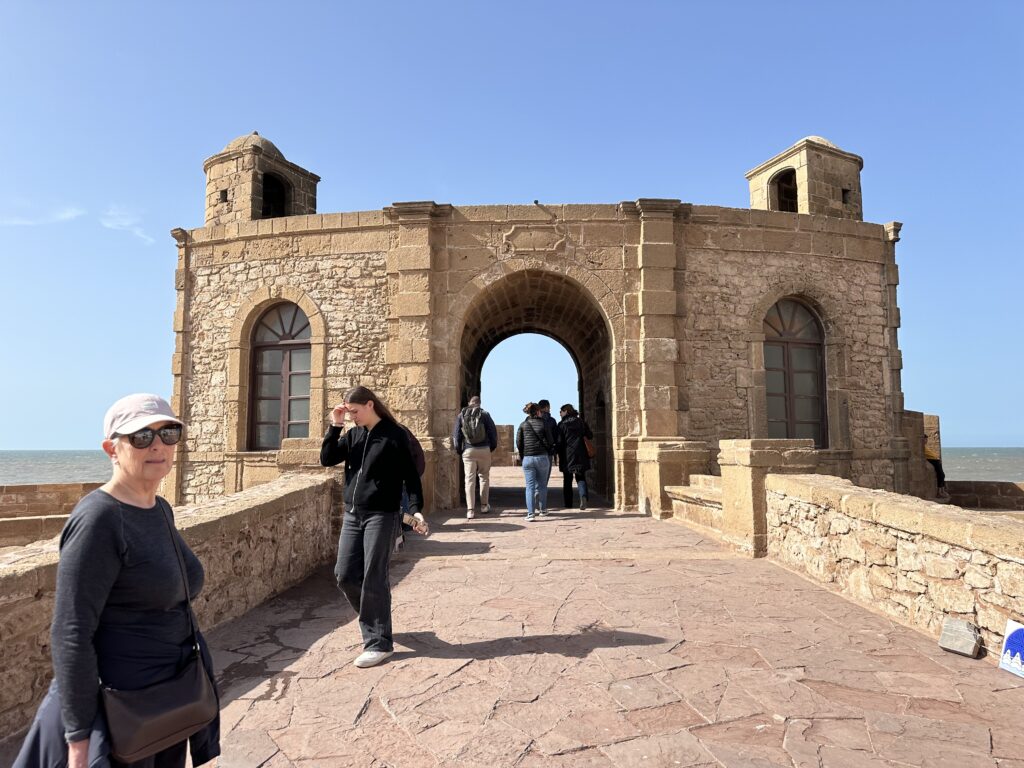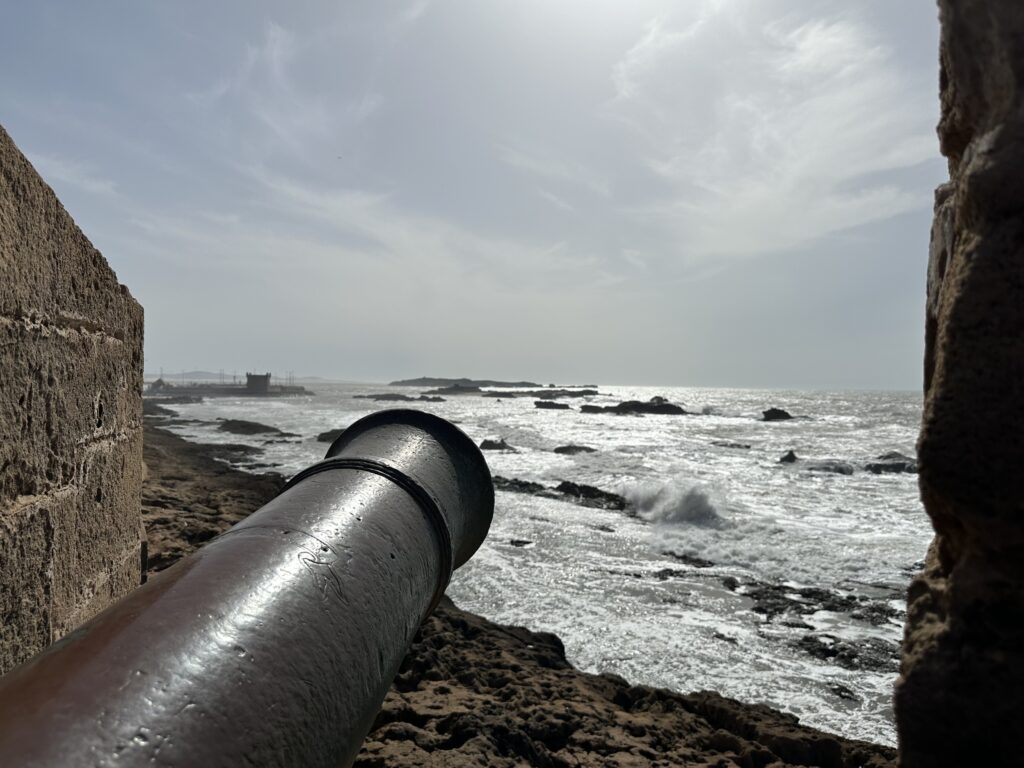We began our tour with an overnight visit to the seaside city of Essaouira. We wanted to see the coast before heading further inland, and Essaouira, in particular, was of interest, partly for its links to Saint-Malo, one of our favourite towns in France. Occupied since prehistoric times, the present city of Essaouira was built during the mid-18thC by Mohammed III, a Moroccan king, who engaged a French architect , Théodore Cornut, among others, to develop a fortress and modern international port and city. Cornut built the walls modelled on the city of Saint-Malo. Walking around the city and its walls overlooking the sea, brought back happy memories of our visit to that French port with the whole family in 2019. From the time of its rebuilding until the end of the 19thC, Essaouira served as Morocco’s principal port. Goods from sub Saharan Africa came from Timbuktu, then through the desert and over the Atlas Mountains to Marrakech and on to Essaouira. After some years of decay when Morocco was a protectorate of France, the city revived in the late 20C and is now a UNESCO world heritage site.
Normally in his office, Hamid elected to drive us in order to give one of his drivers a day off. Along the route, we passed many olive groves (both domestic and Spanish varieties), fields of melons and ripe green beans, wheat and other crops. The land looked dry, but we were told that the water table is high and easily accessible by wells. When Paul expressed a liking for North African “Saharan Blues” music, Hamid introduced us to bands such as Tinariwen and Daraa Tribes. In turn, Paul introduced Hamid to one of his favourite albums, Talking Timbuktu, by Ali Farka Toure and Ry Cooder.
After an espresso break (Segafredo – 7/10), we entered the region of Argan forests. Indigenous to Morocco and southwestern Algeria, Argan oil has traditionally been used in Morocco for cooking, prepared from roasted Argan kernels (e.g., to dip bread at breakfast, as a salad dressing, or to drizzle on couscous or pasta), but gained popularity in the 2000’s as a cosmetic ingredient. At a women’s cooperative, we observed the manual process of extraction. The unroasted kernels are extracted from ripe fruit which has been sun-dried for a few weeks, the dried peel removed and the kernels crushed to produce the oil. The remaining mash is kneaded by hand to produce more oil. Lois bought some of the products to support the women (as well as for cosmetic use!) Hamid informed us that the king sanctioned the creation of women-only cooperatives, but at least one investigator showed that not all coops operate as originally intended.
We took advantage of Hamid’s presence to quiz him about Morocco, its history and culture. He is proud to be Amazigh, the indigenous people of North Africa, previously referred to as Berbers. While also Muslim. the Amazigh have retained their own cultural practices, language and alphabet, despite pressures to assimilate. Outside of the cities, the Amazigh live in distinct communities. Although the Moroccan Constitution recognizes the Amazigh identity and language, rules for officially implementing these rights are still evolving. Morocco has not adopted the UN Declaration on the Rights of Indigenous Peoples.
Arriving at Essaouira, we were required to park outside of the Medina (next to Orson Welles Park commemorating the making of the 1951 movie, Othello, on location in Essaouira ). We walked to our hotel, a porter transferring our luggage in a trolley. Leaving Hamid, we lunched on a very good seafood chowder and then went down to the beach in front of the city walls, clambering over volcanic rock and watching the Atlantic waves crash to shore. After wandering the souks, we had an enjoyable dinner in the Cafe Sirocco (named after the ever present wind) -freshly-caught sole and delicious chocolate fondant (but, no wine, sigh).
Sunday morning we visited the Bayt Dakira museum commemorating the history of the Jewish community of Essaouira. In the first half of the 19thC, the majority of the population of the city was Jewish as in the previous century Mohammed III encouraged Moroccan Jews to settle in the town and handle the trade with Europe. According to Wikipedia “Changes in trade, the founding of Israel, the resulting wars with Arab states, and the independence of Morocco all resulted in Sephardic Jews leaving the country. As of 2017, Essaouira had only three Jewish inhabitants.” This account does not make reference to the severe discrimination against the community during the first half of WWII when the Vichy controlled the country. The museum houses the Haim and Célia Zafrani Research Center on the History of Relations between Judaism and Islam.
We continued our wanderings into craft shops until lunch when Paul enjoyed a tartine with eggplant and sardines and Lois had fresh green pea soup with mint. The drive back to Marrakech was uneventful, but included a stop for tea for us and prayers for Hakim.
We checked into Perlekech Riad, another gem, and had a seafood feast of scallops and gambas.














Oh you two wonderful people are off to amazing start. How do you find all these places and people. Weather looks great and the food delicious. I will enjoy your journey reading and seeing it
Hi dear friend, you are with us in spirit! Hugs to Kate. xo
What a wonderful start and how do you find theses places and people. Places look lovely and food delicious. Looking forward to reading more.
Surprisingly little changes from my memories
Did you see Jimi Hendrix when you were there?
It sounds like you are really enjoying your time in Morocco, including lots of delicious food.
It’s been an amazing trip, such a privilege to experience, if only a small taste.